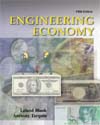Count on our SPREADSHEETS:
The use of spreadsheets has earned this edition high praise! Blank and Tarquin walk students through the use of Excel, from the basics of setting up a spreadsheet for calculations, to sophisticated techniques using Excel Solver. Excel screen shots are tagged with cell labels to help students see how to set up their spreadsheets. However, the spreadsheet presentation is well balanced with hand solution of examples, problems, and case studies. Trust our ORGANIZATION:
Teach the chapters in order or rearrange the chapters to suit your needs. While the chapters are progressive, over three-quarters can stand alone, allowing great flexibility. By design the chapters have been graphically cross-referenced using margin notes to indicate related topics and hints on quick-solve spreadsheet solutions. This allows the reader to move through a chapter with all references to information in other chapters at their fingertips. However, if you do work through the book sequentially you will discover that the chapters have been reorganized to improve the flow of topics. Rely on our CURRENCY:
New material is included on public sector projects, cost estimation, minimum attractive rate of return, and economic value added. The chapters on factor derivation and usage, cost estimation, replacement studies, and after-tax evaluation have been heavily revised to reflect current professional use. New sections in Chapter 9 cover public sector vs. private sector projects. Expect our EXTENDED EXERCISES:
Extended exercises appear in almost every chapter. These exercises, new to this edition, emphasize the power and versatility of spreadsheets in performing sensitivity analysis. Believe in our CASE STUDIES:
The single biggest change in this edition from the last is the presentation of case studies. There are twice as many cases in this edition as in the fourth edition. These case studies allow the reader the opportunity to look at real-world issues from the inside of the problem rather than relying on a description from the outside. Furthermore, these case studies are integrally tied to the learning objectives of each chapter and they retain the easy-to-read writing style seen throughout the book. There is no chance the reader will miss the big picture!
Heavily revised to emphasize the tools students will use in professional practice, Engineering Economy, 5th edition offers the following: - Over 90% of the chapter homework problems are new or revised.
- FE Exam-type problems in every chapter give students practice tools for preparing for the Fundamentals of Engineering exam.
- Chapter 11 offers a simplified treatment of replacement study procedure in a 3-step process.
- Chapter 15 contains a completely rewritten treatment of cost estimation.
- Chapter 16 now separates tax depreciation and book depreciation.
- Chapter 17 has a completely restructured presentation of tax and after-tax material.
- A Web site contains links to current tax rules and regulations and other resources.
| 


 2002 McGraw-Hill Higher Education
2002 McGraw-Hill Higher Education

 2002 McGraw-Hill Higher Education
2002 McGraw-Hill Higher Education